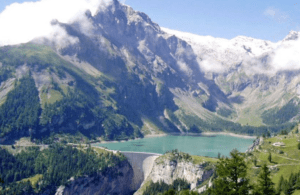
A documentary video recently released by drone development company senseFly captures not only some pretty dramatic scenery (via drone, of course) but also helps to illustrate some of the benefits of using drone technology to help inspect key infrastructure.
Released as part of a case study of a project that the company undertook with Electricité de la Lienne and Energies Sion Région, the video documents the inspection and post inspection process of the downstream face of Tseuzier dam, a more than 500-foot-tall, arched structure on the Lienne River in Switzerland.
The goal of the project was to produce a high-resolution photographic record that could be used as part of an inspection report submitted to the country’s energy regulator every five years.
The imagery was captured with a senseFly albris drone, processed with Pix4Dmapper Pro software, and analyzed by an experienced civil engineer.
It took about 50 flights to fully cover the approximately 200,000 square feet of surface area. Over the course of a two-week period, 7K images were taken and processed, resulting in four high-resolution orthophotos, a digital point cloud, and a full defect report.
Previously, engineers have captured the data manually, visually inspecting the dam from a hanging basket lowered down the highly convex structure on cables, Perraudin said, adding that the process took about three weeks and could only be done during winter.
“Future inspection campaigns [with a drone] can be carried out using the exact same shooting conditions, meaning we will be able to make absolutely reliable comparisons—a major benefit when monitoring a dam, tracking its degradation, the evolution of certain cracks, the supporting rock, and degradation of the surrounding cliffs,” Perraudin said.
Read the complete case study here (.pdf).
Alan is serial entrepreneur, active angel investor, and a drone enthusiast. He co-founded DRONELIFE.com to address the emerging commercial market for drones and drone technology. Prior to DRONELIFE.com, Alan co-founded Where.com, ThinkingScreen Media, and Nurse.com. Recently, Alan has co-founded Crowditz.com, a leader in Equity Crowdfunding Data, Analytics, and Insights. Alan can be reached at alan(at)dronelife.com